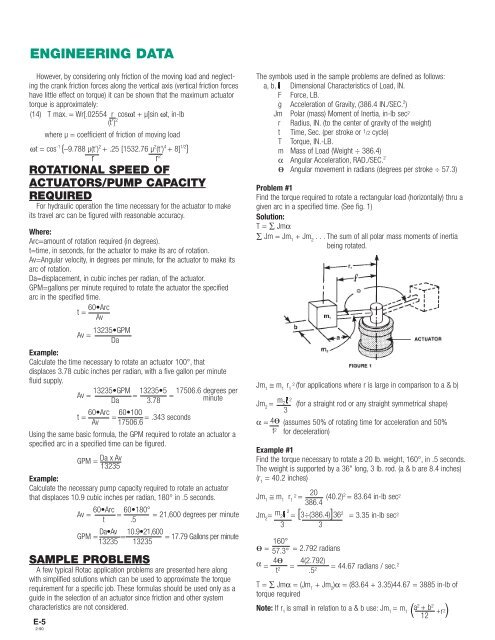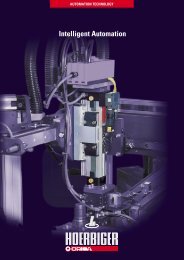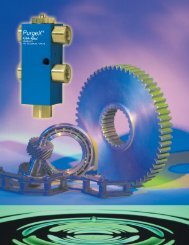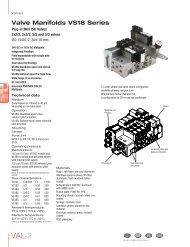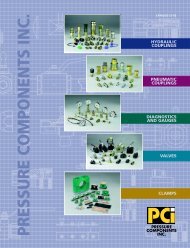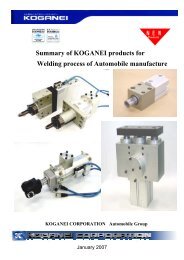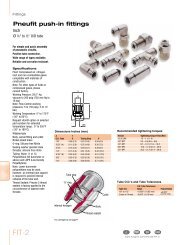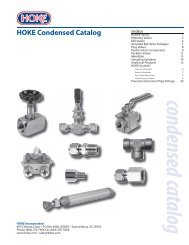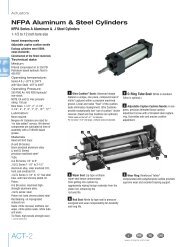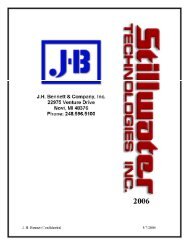Hydraulic Rotary Actuators
Hydraulic Rotary Actuators
Hydraulic Rotary Actuators
Create successful ePaper yourself
Turn your PDF publications into a flip-book with our unique Google optimized e-Paper software.
ENGINEERING DATA<br />
However, by considering only friction of the moving load and neglecting<br />
the crank friction forces along the vertical axis (vertical friction forces<br />
have little effect on torque) it can be shown that the maximum actuator<br />
torque is approximately:<br />
(14) T max. = Wr[.02554 r cosωt + µ]sin ωt, in-lb<br />
(t’) 2<br />
r r 2<br />
ROTATIONAL SPEED OF<br />
ACTUATORS/PUMP CAPACITY<br />
REQUIRED<br />
For hydraulic operation the time necessary for the actuator to make<br />
its travel arc can be figured with reasonable accuracy.<br />
Where:<br />
Arc=amount of rotation required (in degrees).<br />
t=time, in seconds, for the actuator to make its arc of rotation.<br />
Av=Angular velocity, in degrees per minute, for the actuator to make its<br />
arc of rotation.<br />
Da=displacement, in cubic inches per radian, of the actuator.<br />
GPM=gallons per minute required to rotate the actuator the specified<br />
arc in the specified time.<br />
t = 60•Arc<br />
Av<br />
Example:<br />
Calculate the time necessary to rotate an actuator 100°, that<br />
displaces 3.78 cubic inches per radian, with a five gallon per minute<br />
fluid supply.<br />
Av = 13235•GPM = 13235•5 17506.6 degrees per<br />
=<br />
Da 3.78 minute<br />
Using the same basic formula, the GPM required to rotate an actuator a<br />
specified arc in a specified time can be figured.<br />
Example:<br />
Calculate the necessary pump capacity required to rotate an actuator<br />
that displaces 10.9 cubic inches per radian, 180° in .5 seconds.<br />
SAMPLE PROBLEMS<br />
A few typical Rotac application problems are presented here along<br />
with simplified solutions which can be used to approximate the torque<br />
requirement for a specific job. These formulas should be used only as a<br />
guide in the selection of an actuator since friction and other system<br />
characteristics are not considered.<br />
E-5<br />
2-90<br />
where µ = coefficient of friction of moving load<br />
ωt = cos -1 {–9.788 µ(t’) 2 + .25 [1532.76 µ 2 (t’) 4 + 8] 1/2 }<br />
Av = 13235•GPM<br />
Da<br />
t = 60•Arc = 60•100 = .343 seconds<br />
Av 17506.6<br />
GPM =<br />
Da x Av<br />
13235<br />
Av = 60•Arc = 60•180° = 21,600 degrees per minute<br />
t .5<br />
GPM = Da•Av = 10.9•21,600 = 17.79 Gallons per minute<br />
13235 13235<br />
The symbols used in the sample problems are defined as follows:<br />
a, b, Dimensional Characteristics of Load, IN.<br />
F Force, LB.<br />
g Acceleration of Gravity, (386.4 IN./SEC. 2 )<br />
Jm Polar (mass) Moment of Inertia, in-lb sec 2<br />
r Radius, IN. (to the center of gravity of the weight)<br />
t Time, Sec. (per stroke or 1 /2 cycle)<br />
T Torque, IN.-LB.<br />
m Mass of Load (Weight ÷ 386.4)<br />
α Angular Acceleration, RAD./SEC. 2<br />
θ Angular movement in radians (degrees per stroke ÷ 57.3)<br />
Problem #1<br />
Find the torque required to rotate a rectangular load (horizontally) thru a<br />
given arc in a specified time. (See fig. 1)<br />
Solution:<br />
T = ∑ Jmα<br />
∑ Jm = Jm 1<br />
+ Jm 2<br />
. . . The sum of all polar mass moments of inertia<br />
being rotated.<br />
Jm 1<br />
≅ m 1<br />
r 1<br />
2 (for applications where r is large in comparison to a & b)<br />
Jm 2<br />
=<br />
m 2 2 (for a straight rod or any straight symmetrical shape)<br />
3<br />
α = 4θ (assumes 50% of rotating time for acceleration and 50%<br />
t 2 for deceleration)<br />
Example #1<br />
Find the torque necessary to rotate a 20 lb. weight, 160°, in .5 seconds.<br />
The weight is supported by a 36" long, 3 lb. rod. (a & b are 8.4 inches)<br />
(r 1<br />
= 40.2 inches)<br />
Jm 1<br />
≅ m 1<br />
r 2<br />
1<br />
=<br />
20<br />
(40.2) 2 = 83.64 in-lb sec<br />
386.4<br />
2<br />
Jm 2<br />
= m 2 2 = [3÷(386.4)]36 2 = 3.35 in-lb sec 2<br />
3 3<br />
160°<br />
θ = 57.3° = 2.792 radians<br />
α 4θ 4(2.792)<br />
= = = 44.67 radians / sec.<br />
2<br />
t 2<br />
.5 2 ( a2 + b 2 +r 2 )<br />
T = ∑ Jmα = (Jm 1<br />
+ Jm 2<br />
)α = (83.64 + 3.35)44.67 = 3885 in-lb of<br />
torque required<br />
Note: If r 1<br />
is small in relation to a & b use: Jm 1<br />
= m 1<br />
12


